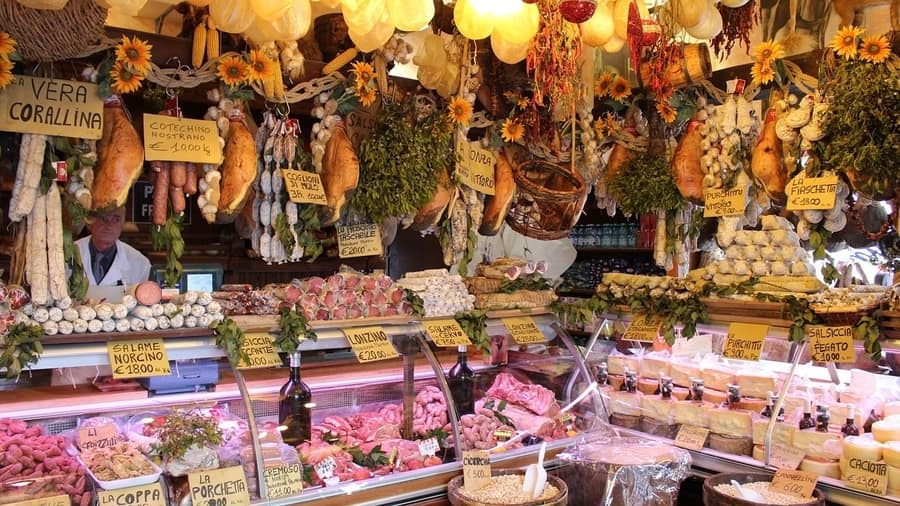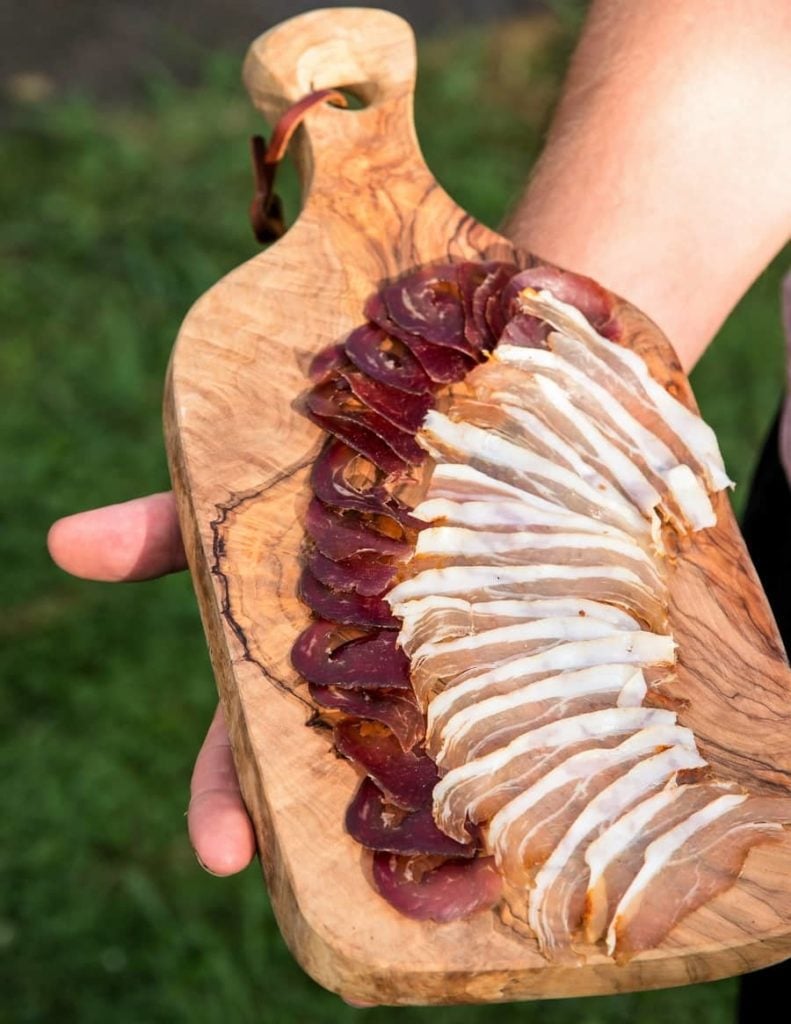When it comes to charcuterie and cured meats in all their forms, most of what I’ve made, seen, and eaten over the years has been naturally gluten-free. Still, it’s worth digging into the details because not every product that falls under the “charcuterie” umbrella is created equal.
Traditional dry-cured meats, salami, rillettes, and confit are usually gluten-free. It’s the more processed, budget-friendly deli meats—bier sticks, bologna, and other emulsified products—where gluten can sometimes appear as filler or binder.
Many people don’t realize that some charcuterie products include small amounts of flour or starch. These are often used for binding, texture, or water retention. In artisan products, they’re unnecessary. In mass-produced ones, they’re a shortcut to cheaper manufacturing.
Whenever I buy from a supermarket, I take a close look at the ingredients list. That’s the only reliable way to know whether a product contains gluten. Over the years I’ve seen every variation—from clean, salt-only traditional recipes to heavily processed versions full of fillers.

I’ve learned that most mass-market charcuterie is made for efficiency and profit, not craftsmanship. Cheap fillers—sometimes gluten-based—make production cheaper and shelf life longer. In contrast, quality small-batch charcuterie relies on good meat, salt, and time.
In places like Italy or France, where food culture is part of everyday life, I’ve noticed far fewer unnecessary additives. When I’ve browsed local markets there, even the “junk food” sections had fewer processed snacks than you’d find in most supermarkets elsewhere.
The best rule of thumb is simple: read the ingredients. Even though charcuterie is often gluten-free by nature, only the label will tell you for sure.
What Counts as Charcuterie?
Charcuterie has taken on a much broader meaning these days. It used to describe French techniques for curing and preserving meat—things like confit, pâté, and dry-cured ham. Now, the term often refers to a full board of meats, cheeses, pickles, chutneys, and crackers served together.
That means gluten can enter the picture in different ways depending on what’s on the board. The meats themselves are usually fine; the crackers, spreads, or mass-made sausages are where gluten is most likely to appear.
Which Charcuterie Is Naturally Gluten-Free
Most traditional charcuterie is made from simple ingredients — meat, salt, and time. When you stick to these fundamentals, gluten doesn’t belong anywhere in the process. Problems only arise with shortcuts, binders, or bulk fillers added to speed up production or stretch the meat further.
Traditional Dry-Cured Meats
Dry-cured meats like prosciutto, pancetta, coppa, and bresaola are naturally gluten-free. These are whole-muscle cuts cured with salt, sometimes spices, and then slowly dried until they’re firm and preserved. No flours, starches, or additives are needed.
That’s why I focus so much of my work around this kind of curing. When made correctly, dry-cured meats are some of the cleanest and simplest preserved foods you can make at home. I’ve even shared my guide on how to cure meat in a regular fridge for anyone starting out without a curing chamber.

Maintaining the right drying conditions is key. Proper temperature and humidity for meat curing allow natural fermentation and flavor to develop safely — no need for binders or gluten-based stabilizers.
Confit, Rillettes, and Pâtés
These classic French preparations fall under the charcuterie category as well. Confit and rillettes are slow-cooked meats preserved in their own fat — typically duck or pork. They rarely, if ever, contain gluten unless served with bread or toast on the side.
Pâtés are a little different. Many commercial pâtés use breadcrumbs or flour as binders for texture. When I make pâté at home, I skip these entirely and use reduction and fat for stability instead. It gives a better texture and flavor without any gluten risk.
Fresh Sausages and Fillers
Fresh sausages are one of the biggest gluten question marks in charcuterie. Unlike dry-cured meats, they often contain fillers for texture, especially in mass-market versions. Breadcrumbs, wheat starch, or flour are common binders used to help the meat retain water and appear smoother.
When I make sausages myself, I use lean meat, fat, and seasoning only. Natural binding happens through protein extraction — no added gluten or starch needed. Commercial sausage makers, however, often take the cheaper route.
Processed Deli Meats and Emulsified Products
Products like bologna, bier sticks, or spam can include a mix of starches and flours to stabilize their texture. These are technically cured meats, but they’re also highly processed. It’s common to see wheat or modified starches listed among the ingredients.
If you want to stick with gluten-free options, focus on whole-muscle dry-cured meats or quality artisanal salami instead of these industrial versions. Those will always give you the best balance of purity and flavor.
For a look at what goes into every recipe, you can explore the main ingredients for curing meat — a guide that covers salts, spices, and optional curing salts I use for both short and long-term preservation.
Everything I’ve described above — from dry-cured salami to confit and rillettes — can be made without gluten. The difference always comes down to craftsmanship versus mass production.
How to Check for Gluten in Cured Meats
The easiest way to stay gluten-free with charcuterie is to read the label carefully. Regulations in most countries require clear allergen listings, so if gluten, wheat, or any derivative is present, it must appear in the ingredients or allergy warning section.
I’ve made it a habit to check every package, even when I’m buying something I think I already know. Some brands change recipes or suppliers over time, and that’s often when hidden gluten shows up.
Recognizing Gluten-Containing Ingredients
Look for terms like “wheat starch,” “barley malt,” “modified food starch,” or “flour.” They’re often added for texture, moisture control, or binding. Gluten-free alternatives, like potato or rice starch, are completely safe and can appear in small-batch charcuterie without concern.
Flour-based binders are common in cheaper deli meats or pâtés, while traditional salumi-style products rarely use them. That’s a big reason why I recommend sourcing from artisans or making your own — you control every ingredient.
Certified Gluten-Free & Artisanal Brands
Some modern brands now carry certified gluten-free labeling, which can give you peace of mind. I tend to look for shorter ingredient lists and clear labeling from producers that focus on quality. If you’re not sure, reach out to the producer; smaller operations are often transparent and happy to share their process.
Artisan butchers, small charcuterie producers, and local markets are also good places to find clean-label options. When they’re working from traditional recipes, gluten simply isn’t part of the equation.
Making Your Own Gluten-Free Charcuterie
When you make your own cured meats, you know exactly what’s going in. Whether it’s salami, bresaola, or pancetta, the only essential ingredients are salt, time, and proper drying conditions. I’ve written detailed guides on how to build a meat curing chamber and how to cure meat in a fridge that cover both simple and advanced setups.
Good airflow, temperature, and humidity control are what keep cured meat safe, not gluten or other fillers. With the right environment and a bit of patience, you can produce better, safer results than most commercial products — and keep them completely gluten-free.
Once you’ve tasted the difference between homemade charcuterie and mass-produced versions, you realize how much quality and simplicity matter. For anyone sensitive to gluten, that’s the biggest advantage — total control from start to finish.
My Gluten-Free Charcuterie Projects
Over the years I’ve made a lot of cured meats at home, and every one of them has been gluten-free. The beauty of dry curing is that the process doesn’t need anything beyond meat, salt, spices, and time. It’s all about control, patience, and understanding how to create the right environment for preservation.
- Dry-Cured Salami
- Pancetta and Guanciale
- Bresaola and Coppa
- Smoked Duck and Wild Turkey
- Dry-Cured and Smoked Salmon
- Hot-Smoked Fish Pâtés
Every one of these projects is made with whole-muscle meat and pure ingredients. I don’t use starches, flours, or fillers of any kind. It’s part of what makes traditional charcuterie both clean and delicious.
For anyone interested in getting started, I’ve written detailed guides on curing, drying, and smoking at home. A good starting point is my post on how to cure meat in a regular fridge — a practical entry into gluten-free charcuterie that doesn’t need special gear.
Quick Reference: What May Contain Gluten
Here’s a quick guide I use to identify which types of charcuterie are safe, worth checking, or best avoided when following a gluten-free diet:
| Category | Gluten-Free? | Notes |
|---|---|---|
| Dry-Cured Meats (Prosciutto, Pancetta, Bresaola) | Yes | Traditional recipes contain no gluten; made from whole muscle and salt. |
| Artisan Salami | Yes | Usually gluten-free; always check ingredient list for binders. |
| Pâté & Rillettes | Check | Some commercial versions use breadcrumbs or flour as binders. |
| Fresh Sausages | Check | Often contain fillers like breadcrumbs or wheat starch. |
| Processed Deli Meats (Bologna, Bier Sticks) | Often Not | May include starch or gluten-based fillers for binding and texture. |
| Crackers & Bread on Boards | No | Almost always wheat-based; opt for gluten-free alternatives. |
Most of the time, gluten only appears when convenience and cost outweigh quality. If the ingredients list is short and recognizable, it’s usually a good sign you’re dealing with genuine, naturally gluten-free charcuterie.
Traveling or Buying Abroad
When I’m in places like Italy, Spain, or France, I rarely need to worry about gluten in cured meats. Traditional producers there still follow old methods that rely purely on salt and time. Labels might be in another language, but the ingredient lists are short and easy to recognize.
If you’re traveling somewhere with looser labeling standards, ask for local cured meats from markets or butchers. You’ll often get far better products than what’s wrapped in plastic on a supermarket shelf — and much less chance of gluten hiding in the recipe.
Expert Tip: Keep It Simple and Traditional
The most reliable way to avoid gluten in charcuterie is to keep it simple. Choose products that have been made traditionally, or make them yourself. If the ingredient list is longer than a few lines, chances are it includes something unnecessary — often a starch, filler, or binder that doesn’t belong.
Traditional methods of curing meat rely on time, salt, and technique. Once you learn to manage temperature, airflow, and humidity, gluten never enters the picture. It’s a cleaner, more flavorful, and far more authentic way to enjoy charcuterie.
Is all charcuterie gluten-free?
No, but most traditional charcuterie is naturally gluten-free. Dry-cured meats such as prosciutto, pancetta, and bresaola contain no flour or starch. Processed deli meats and fresh sausages are the ones that may include gluten as binders.
Does salami have gluten?
Traditional salami made with meat, salt, and spices is gluten-free. Industrial salami may include fillers or wheat starch to absorb moisture, so always check the label or buy from an artisanal maker.
Can pâté or rillettes contain gluten?
Sometimes. Homemade or traditional versions usually do not, but commercial pâtés often include breadcrumbs or flour as a binder. If it’s store-bought, check for wheat or flour in the ingredients list.
Have you come across any charcuterie that surprised you by containing gluten? Share your experience or ask a question in the comments below — I always enjoy hearing how others navigate this fascinating world of cured meats.

Tom Mueller
For decades, immersed in studying, working, learning, and teaching the craft of meat curing, sharing the passion and showcasing the world of charcuterie and smoked meat. Read More
